The Paleo Diet
By now, you have probably heard of the Paleolithic diet (Paleo diet) and dismissed it as just another fad. The word "diet" brings up a great many negative connotations, but don't let the word "diet" confuse you.
The Paleo Plan or Eating Plan would have been a better choice of words. Because while Paleo usually causes people to lose weight, it's more of a lifetime way of eating healthy, rather than a "diet", where people eat certain foods for a short time, then quit once they reach their goal weight.

This eating plan is similar to the low carb way of eating, but unlike other extreme forms of low carb diets, such as the ketogenic diet, you don't need to count carbs on the Paleo diet.
Paleo Diet Principles
The basic idea here is to eat like a caveman, hence the name. In other words, before you pop something into your mouth, think for a minute. Would a cave man have been able to eat this? If not, then pick something else.
Studies in trials have shown that at 3, 6, and 12 month intervals, overweight people saw more success at weight loss using low-carb diets like Paleo, than lower fat diets (1).
Our ancestors consumed things they could either hunt or gather. While many people think this means they had a mainly vegetarian diet, this isn't really accurate. This means things such as bread, pasta, candy, dairy, and potato chips are no longer allowed, but things such as fish, beef, vegetables, seeds, nuts, and chicken are now the mainstays of your diet.
Why Follow the Paleo Diet?
Current nutritional research links diseases such as type 2 diabetes, heart disease, autoimmune disorders, and even some cancers, with eating too many processed foods, sugars, and refined carbohydrates. Our bodies are not designed to eat these types of foods and the unfortunate truth is that these foods are now staples of the modern American diet. This is why so many people are going gluten free or trying to eat a low carb or vegetarian diet.
By avoiding the disease-causing foods we currently consume and switching to the Paleo diet, people can reap numerous benefits including:
- Clearer skin and healthier hair, nails, and teeth
- Effortless weight loss
- Improved muscle tone and strength
- Increased energy
- Improved sleep
On top of these, let's talk about inflammation. Studies have repeatedly shown refined and processed foods, grains, and dairy can increase inflammation in the body. Inflammation is responsible for numerous health problems, including Alzheimer's, arthritis, heart disease, and even some types of cancer. The Paleo diet is anti-inflammatory in nature, which can offer you tremendous protection from disease.
This is why the Paleo Diet is sometimes called the Anti-inflammatory Diet.
Everyone is interested in a heart healthy diet and since the Paleo plan encourages the consumption of omega-3 fatty acids, which are shown to lower bad cholesterol levels and boost the good type of cholesterol, you can rest assured that you are eating for your heart as well as your waistline.
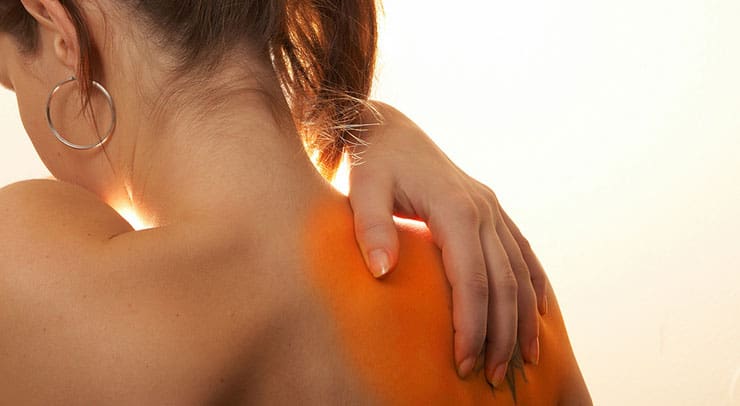 Fight Inflammation with the Paleo Diet
Fight Inflammation with the Paleo Diet
How is Paleo Different from Whole 30?
The Whole 30 diet is similar to Paleo, but only stricter. This plan is designed to help cut cravings and prepare you for the Paleo diet. The Whole 30 plan is a 30 day plan only, while Paleo is intended to be a lifelong way of eating.
Paleo & Weight Loss
Although every diet claims to be effective for weight loss, many cannot live up to those claims. Paleo, however, has proven itself to be excellent when it comes to weight loss.
By supplying the body with a great deal of lean protein in the form of meat, the body can develop more lean muscle mass, which burns far more calories than fat. More muscle also means more effective workouts, which mean more fat burning with every move.
By cutting out refined carbs and sugar, your insulin levels remain low. This means the body will store less fat, as well as have more stable blood sugar levels.
Numerous studies have shown that a low carb diet helps people lose weight faster than a vegetarian diet or low calorie diet.
What Can I Eat on the Paleo Diet?
Unlike the typical low fat or low calorie diet, the list of foods on the Paleo plan is super tasty. You literally have thousands of recipes right at your fingertips (online) so you never get bored.
Meat and Eggs
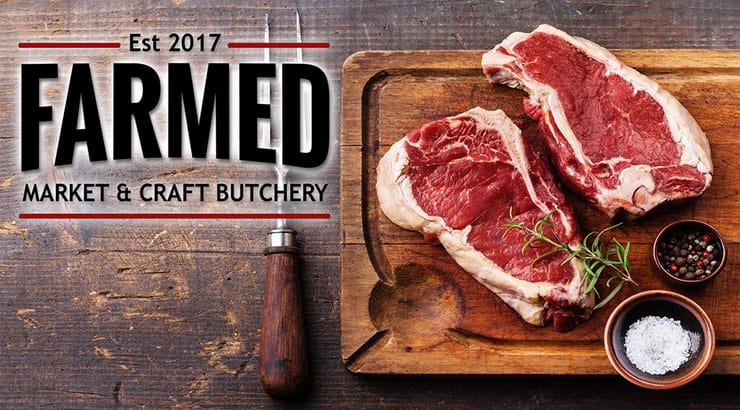
Try your best to use free-range, pastured, and antibiotic- and hormone-free meats.
- Beef
- Bison
- Chicken
- Fish
- Turkey
Keep in mind that the meat and seafood that our ancestors ate didn't come shrink-wrapped and pumped full of antibiotics, hormones, and extra sodium. That's why the Paleo lifestyle encourages choosing grass-fed, pastured meats; wild-caught fish and wild-caught or farmed shellfish.
For all recipes that call for meat ingredients, try your best to use free-range, pastured, and antibiotic- and hormone-free meats. The word organic does not always mean pastured, but at the very least, it suggests the animal ate a healthier diet. Choose eggs from free range chickens. These birds eat a much more natural diet and, therefore, have mega amounts of Omega-3 fatty acids.
Farmers' markets are the best sources of high-quality proteins, but shopping this way is not always financially or geographically possible. See if your city has a community-supported agriculture (CSA) program to buy meat, vegetables, fruits, and eggs in bulk. There might be a Paleo-supportive gym or group in your area which work directly with local, sustainable farmers to offer such food shares. When shopping at the grocery store, watch out for false claims and always read the labels and ingredient lists carefully.
When purchasing bacon, make sure it is nitrate-free and watch out for the excess use of sugars and salts in the ingredients. Try to select bacon made from pastured, free-range pork or try turkey bacon.
Sausages and hot dogs often contain excess sodium, nitrates, and other additives. A Paleo-friendly sausage will use natural animal casings and contain good-quality meat, some spices, and minimal amounts of salt.
For seafood, the same rules apply. Whenever possible, go directly to the source (fisherman's wharfs, piers, or farmer's markets) to get the freshest possible, wild caught seafood.
Of course, if you live hundreds of miles inland, this probably won't be possible. In that case, look for the labels which read "wild caught". Sometimes, however, your only choice is farmed fish. Depending on the type of fish, check government websites for suggestions on how much you can safely eat each week.
Vegetables
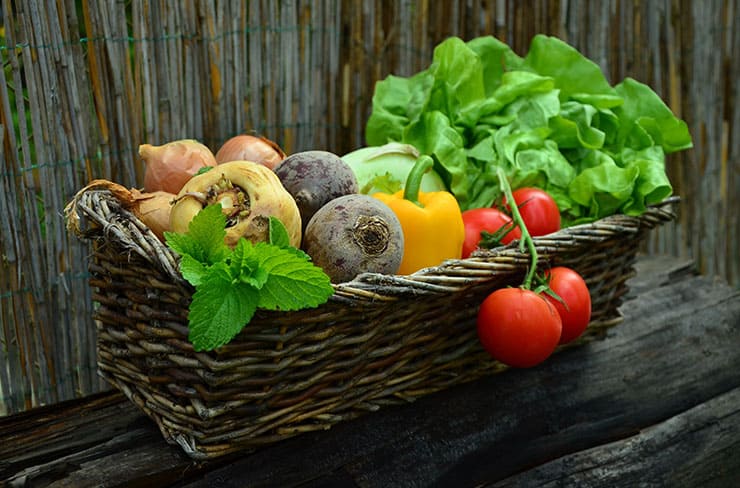
A non-inclusive list of vegetables includes foods like:
- Artichoke
- Jicama
- Green and yellow beans
- Leeks
- Mushrooms
- Bell peppers
- Beets
- Greens (spinach, lettuce, watercress, turnip greens, kale, Swiss chard, etc.)
- Cauliflower
- Broccoli
- Cabbage
- Onions (all kinds)
- Pumpkins
- Squash (butternut and delicate should be limited due to high sugar levels)
- Carrots
- Celery
- Cucumbers
- Garlic
- Tomatoes
- Zucchini
- Radishes
- Peppers
- Okra
- Rutabaga
Sweet potatoes, turnips and the squash mentioned above should be consumed in limited quantities as these have higher sugar levels than other vegetables.
Since vegetables are the mainstay of the Paleo diet, you want to try to eat organic as much as you possibly can. To save money, some vegetables have very low contamination rates and buying traditional isn't a problem. Almost every city has a farmer's market or co-op, where you can buy fresh, organic vegetables.
Fruits
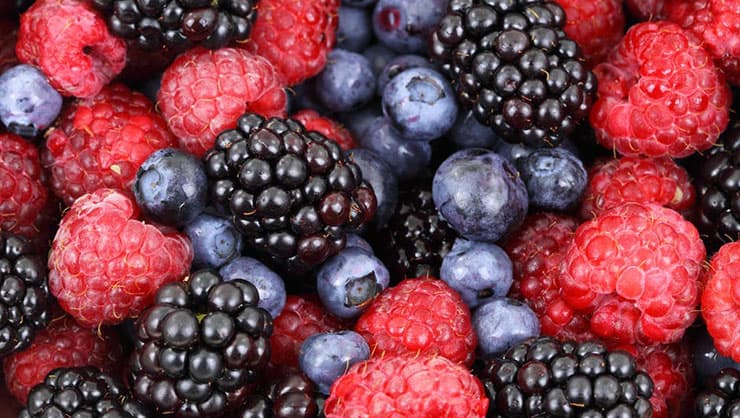
Again, fruits should be organic as much as possible. Since berries were most likely the first fruits our ancestors gathered, consider all berries to be OK.
If you eat dried fruits, be certain they do not contain added sugar. Consider investing in a dehydrator so you can easily dry your own fruit at home.
Keep in mind that juice is not allowed, only the whole fruit. Fruit should be consumed in moderation. You might want to consider taking a vitamin C supplement to ensure that your body gets plenty of this vitamin, which is vital to the immune system.
Some fruits are higher in sugar than others, including bananas, melons, and stone fruit (such as peaches). Consider eating fruit with some fat or protein (apples dipped in nut butter for example) to help prevent blood sugar levels from spiking.
Acceptable fruits are:
- Berries
- Apples
- Cherries
- Dried fruit (apples, cherries, berries, etc.)
- Cranberries
- Goji berries
- Lemons/Limes
- Oranges and grapefruits
Healthy Fats & Oils
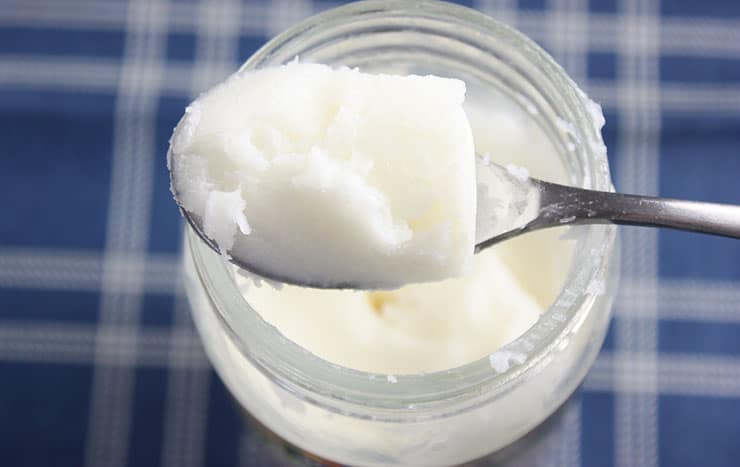 Superfood: Coconut Oil
Superfood: Coconut Oil
Look for natural oils from non-grain and non-GMO sources. This means avoiding corn, soybean, and canola oils. Unrefined oils are far better than refined oils. Butter should come from grass fed cows. If you use nut oils, such as almond oil, do not use them for cooking as they break down under heat.
Acceptable oils and healthy fats include:
- Olive oil
- Almond oil
- Unfiltered Flaxseed oil
- Avocado oil
- Coconut oil (unrefined)
- Extra virgin olive oil
- Grape seed oil
- Walnut oil
- Sesame seed oil
- Avocados and Coconuts, unsweetened
- Butter
- Ghee
Nuts & Seeds
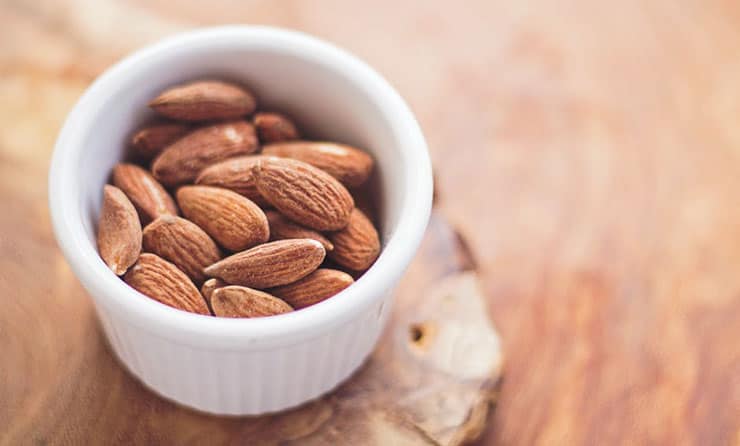 Almonds. Be certain that nuts and seeds are unsalted and have no added sugar.
Almonds. Be certain that nuts and seeds are unsalted and have no added sugar.
Read labels to be certain that nuts and seeds are unsalted and have no added sugar. Although raw nuts have more nutrition in them, some people find them difficult to digest. Roasted nuts are fine as long as they don’t contain any added salt or hidden sugars. You can also try soaking raw nuts overnight before consuming them to see if your stomach is able to handle them more easily.
Acceptable nuts and seeds:
- Chia seeds
- Almonds
- Brazil nuts
- Flaxseeds
- Hazel nuts
- Macadamia nuts
- Pistachios
- Walnuts
- Pumpkin seeds
- Sunflower seeds
- Sesame seeds
Natural Sweeteners
This can be a difficult subject as some people feel that even natural sweeteners, such as honey, are the same as consuming sugar and should be avoided. Others, however, feel that our ancestors surely ate honey and maple syrup on occasion. The key here is moderation. A bit of honey or maple syrup, raw agave nectar, and coconut sugar can be consumed and shouldn’t cause any problems.
Condiments
While no one can deny that condiments, such as mustard and vinegar, can help to spice up foods, the problem is that most of these commercially made items contain added sugar and/or salt. Read labels carefully to ensure that you are getting as natural a product as possible, or consider making your own condiments at home.
Beverages
Like most diets, you should try to concentrate on water. While most people think that 8 glasses of water is sufficient, the truth is that 8 glasses should be considered the minimum, not the maximum. Aim to drink two to 3 liters of water each day. If you get really bored, put a squeeze of lemon or lime in your water.
Other acceptable beverages include:
- Sparkling water (add a squeeze of lime or lemon to these also)
- Coffee
- Tea
- Unsweetened coconut water (read labels carefully)
- Unsweetened nut milks (read labels carefully or make them at home)
Seasonings and Spices
There is no doubt that spices and seasonings can help to bring out the flavor of food. Some of the best spices to use include items such as:
- Allspice
- Seasoned pepper
- Black peppercorns
- Bay leaves
- Cayenne pepper
- Garlic powder (or fresh garlic)
- Onion powder
- Oregano
- Cinnamon
- Coriander (cilantro)
- Fennel seed
- Red pepper flakes
- Sea salt
- Tarragon
- Thyme
- Sage
- Rosemary
Vinegar can also add a nice touch of flavor. Consider trying new vinegars to keep things interesting. Some of the most common and flavorful vinegars include:
- Red wine
- Coconut
- Apple cider
- Aged balsamic
- Balsamic
- Jalapeno
Supplements
While some people claim that our ancestors didn’t think about eating a “healthy” diet, nor did they take supplements and that they were “fine”, the truth is that most cavemen only lived to be about 25!
There is little doubt that, while they consumed a healthy diet, our ancestors had nutritional deficiencies. To be certain that your body is getting everything it needs to stabilize hormones, improve absorption, and ensure strong bones; the following supplements are a good idea:
- Calcium for strong bones
- Fish or Krill Oil for improved cognitive function, clear skin, lower inflammation levels, and much more.
- Probiotics to improve digestion.
- Vitamin B Complex
- Vitamin C to keep the immune system strong
- Vitamin D which is free in the form of sunlight, but for those with dark skin or those who live in areas where there is little sunlight, especially in winter, a supplement will help
Foods to Avoid
It should seem fairly obvious by now that the foods you are going to avoid will be anything that is "pre-packaged". Our ancestors were not able to buy mac n cheese, donuts, or cereal.
Grains
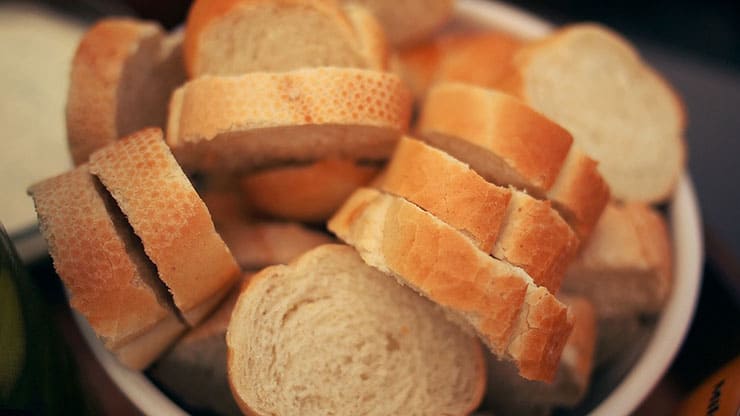
One of the main things you will be avoiding is gluten (grains/wheat). Our ancestors had no way to process these and our digestive system has not changed all that much. Even whole grain types of gluten, such as oats, can lead in inflammation in the body. If you are interested in eating a gluten free diet, this is the eating plan for you! In case you aren't sure which grains and starches you should avoid, the following list should help clear things up:
- Oats
- Millet
- Amaranth
- Barley
- Bread
- Flour (any type of flour)
- Corn or cornmeal
- Kamut
- Rice (brown and white)
- Tapioca
- Spelt
- Wheat
- Potatoes (except sweet potatoes)
Legumes
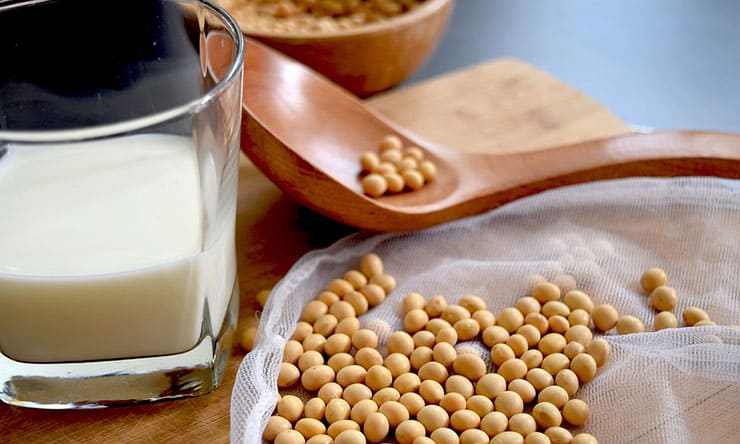
While many people believe that legumes are "natural", the problem is that they can lead to digestive problems as well and lead to serious health issues including autoimmune diseases and inflammation. This means you need to avoid the following:
- Peas (all kinds)
- Soybeans and soy based products
- Peanuts and peanut butter (other nut butters are OK)
- Beans (canned and dried)
Sugar
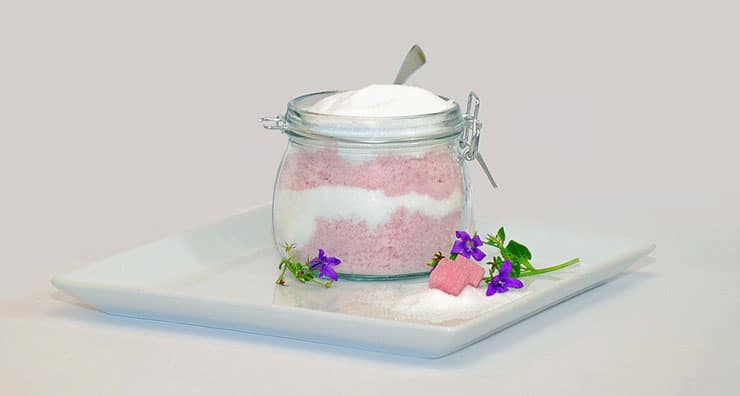
This is another area that should be a given, but let's spell it out to be clear. There are literally thousands of studies which show that refined sugar, especially high fructose corn syrup (HFCS), causes an abundance of health problems. Sugar is addictive. Ever notice how you can be too "full" to eat more meat, but always seem to have room for dessert? Sugar makes the body crave more sugar.
Even artificial sweeteners are dangerous. Even so called "natural" sugars, such as Stevia, trick the body into thinking its eaten calories when it hasn't.
Avoid the following list of sugars and other types of sweeteners:
- Corn syrup
- High fructose corn syrup (HFCS)
- Chocolate (unless it is super dark chocolate)
- Aspartame
- Brown rice syrup
- Candy of any kind
- Cane syrup
- Cane sugar
- Sucralose
- Sugar alcohols (maltitol and sorbitol)
- Splenda
- Stevia
- Saccharine
Dairy
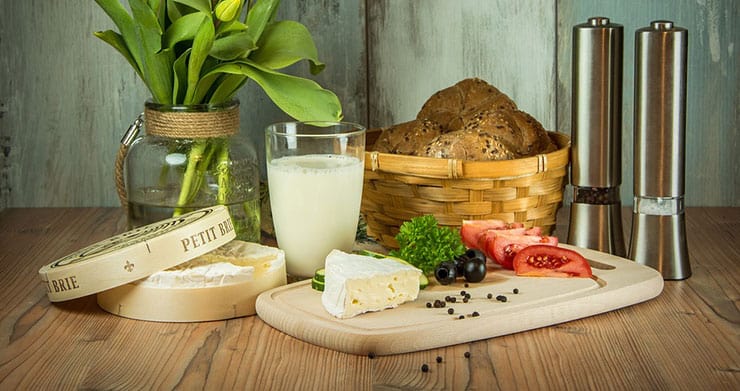
While the USDA tends to push dairy products, especially milk, as a part of a "healthy" diet, many people find that they are lactose intolerant. Humans are the only species which continue to drink milk after being weaned off mother's milk. Calcium can be obtained from other food sources and a supplement will take care of bones and teeth as well as any dairy product.
Paleo followers vary in the use of butter and goat's milk or goat milk products. Some believe that our earliest ancestors used goats for just this purpose. Many infants who cannot digest breast milk or cow's milk can easily consume goat milk.
If you decide to consume these products, do so in moderation. This means no more than 1 serving a day and no more than 3 times a week.
Starchy Vegetables & Fruit
Starchy vegetables and fruit can raise blood sugar, and therefore insulin, levels very much like sugar does. For reasons not yet known, the body does not treat these like vegetables, which means that they don’t burn fat as well as other fiber rich veggies and fruits.
Avoid potatoes (all kinds except sweet potatoes) and bananas.
While some feel that an occasional banana won't hurt them, you might want to try eating a half of a banana with a bit of nut butter. If you feel even hungrier, have a craving for more sugar, or feel that "rush" sugar can bring, this means your blood sugar has spiked and you should avoid bananas in the future.
Canned Fruits
Fruit juice should be avoided as it contains none of the fiber needed to offset the sugar that is naturally found in juice.
The same is true of canned fruit. Almost all canned fruit will contain sodium or some type of sugar or syrup. You are far better off consuming the whole fruit so you get the benefits of fiber.
Alcohol
It's hard to imagine a caveman with a martini in his hand, but some people do choose to make alcoholic drinks a part of their life.
If you decide to drink, avoid beer as it is made from grains. The same is true for dark colored alcohol, such as rum, scotch, and whiskey. These tend to contain unwanted sugars.
Wine is better than hard liquor and red wine is far better than white. Some say that tequila and mescal have very little effect on blood sugar levels.
Regardless of which alcoholic drink you choose, do so in moderation.
Preparing the Pantry and Kitchen
Before you begin shopping, go through your kitchen cabinets and pantry and remove all non-Paleo items. This means tossing out bread, cookies, and leftover candy from the last holiday. Donate unopened items to your local food bank or a homeless shelter.
Be certain that you go through your freezer as well. Toss out frozen waffles, ice cream, frozen bread or pastry items, and sugary treats. You can keep frozen vegetables, but discard frozen potatoes and peas. Let’s not forget to remove yogurt, milk, ketchup, soy, fruit juice, milk, cream, and sugar laden jams and jellies from the fridge.
OK! Now you are ready to go shopping. Take a look at the following list of items to stock your pantry with.
Paleo Shopping List
The Paleo diet means eating natural, wholesome, unprocessed foods. Most people find these foods on the outside aisles of grocery stores. Most grocery stores put boxed or pre-packaged foods in the inner aisles, while staples, such as produce and meat, are found on the perimeters.
Items for baking, and non-dairy items such as almond milk and coconut milk, are often found near the regular dairy items or in the ethnic foods section of your market.
Be certain to read labels carefully. Keep an eye out for sugars, preservatives, stabilizers, or ingredients whose names you cannot pronounce! No salt added canned or boxed tomatoes, tomato sauces, and broths can be found in the lower shelves, below their regular counterparts. When using canned items, be sure that the container does not contain BPA, as this is a known carcinogen. Items in cartons will not have this problem.
Unsalted, roasted, no sugar added nut butters are best. If you cannot find this in your store, buy nuts in bulk and make it yourself at home.
Oils
- Walnut
- Hazelnut
- Flaxseed (unfiltered)
- Almond
- Avocado
- Extra virgin, cold pressed olive oil
- Coconut
(Refrigerate nut oils to prevent them from going rancid quickly)
Fats (Optional)
Again, while some Paleo enthusiasts reject these food items, others find them acceptable. If you wish to include them, add the following to your list:
- Butter (from grass fed cows)
- Palm shortening
- Goat milk or cheese
Nuts and Seeds
To prevent seeds and nuts from going bad, consider freezing them or put them in the refrigerator.
- Chia seeds
- Pumpkin seeds
- Sesame seeds
- Sunflower seeds
- Flaxseeds
- Almonds (raw or roasted, but unsalted and no added sugar)
- Brazil nuts (raw)
- Hazelnuts (raw or roasted, but unsalted and no added sugar)
- Macadamia nuts (same)
- Pistachios (same)
- Walnuts (raw)
Nut Butters
Always read labels carefully. Even brands marked "natural" or "organic" can contain unwanted sugar or salt. Roasted nuts are fine.
- Almond
- Cashew
- Sunflower
Baking Products
To prevent nut flours and coconut from going rancid quickly, store these items in the refrigerator or freezer.
- Pure vanilla extract (not imitation or artificial)
- Almond flour/Almond meal
- Baking powder
- Baking soda
- Raw cacao powder
- Unsweetened chocolate
- Unsweetened cocoa
- Unsweetened coconut flakes
- Coconut flour
Vinegars
- Coconut
- Red wine
- Apple cider
- Balsamic and/or aged balsamic
- Jalapeno
Natural Sweeteners
- Raw honey
- Raw agave nectar
- Medjool dates
- Pure maple syrup (grade B)
Condiments
Read labels carefully as almost all condiments contain some sort of added sugar or are high in salt.
- Hot sauce
- Salsa
- Horseradish
- Dijon mustard
Spices and Seasoning
- Allspice
- Seasoned salt (no added sugar)
- Garlic powder
- Onion powder or flakes
- Oregano
- Bay leaves
- Black peppercorns
- Cayenne pepper
- Fennel seed
- Rosemary
- Sage
- Cinnamon
- Coriander (cilantro)
- Red pepper flakes
- Sea salt
- Thyme
- Tarragon
Miscellaneous Pantry Items
- Low sodium broth (vegetable or chicken) in BPA free containers or in cartons
- Maca powder
- Nori seaweed sheets
- Dried, unsweetened fruits (such as cherries, blueberries, and cranberries)
- Roasted red peppers in glass jars
- Low sodium, gluten free soy sauce
- Tomatoes and tomato sauce in BPA free containers or cartons, no salt added
Necessary Equipment
The following kitchen items will make your life much easier when following the Paleo diet.
- Blender or food processor
- Glass containers (or BPA free containers) for leftovers and snacks
- Mixing bowls
- Oven safe baking pans, sheet trays, and/or glass baking dishes
- Freezer bags
- Large roasting pan
- Measuring cups and spoons
- Glass measuring cups for liquids
- Meat thermometer
- Parchment paper and/or aluminium foil
- Sharp kitchen knives
- Pots and pans made from cast iron, ceramic, glass, or copper
- Rubber tongs and spatulas
- Pepper grinder
- Spice grinder
Other Helpful Items (optional)
- Dutch Oven
- Large stockpot or soup pot
- Mesh bags for produce
- Microwave safe containers
- Muffin and/or bread pans
- Salad spinner
- Spiralizer for making vegetables into noodle shapes
- Dehydrator
- Microwave egg cooker
- Slow cooker or crock pot
- Smoothie shaker
Helpful Tips to Make the Paleo Diet Work for You
- Buy in bulk and freeze meat in smaller packages
- Cook double the amount and freeze the extra for busy nights when there is little time to cook
- Experiment with different types of meat or seafood
- Keep healthy snack ready so you aren’t tempted to cheat
- Eat vegetables at every single meal
- Remember to enjoy fruit, but in moderation
- Eat healthy fats at every meal
- Freeze extra berries
- Save diced veggies for later use in soup or soup stock
- Don't forget to get at least 30 minutes of exercise each day
Paleo Diet Menu Plan
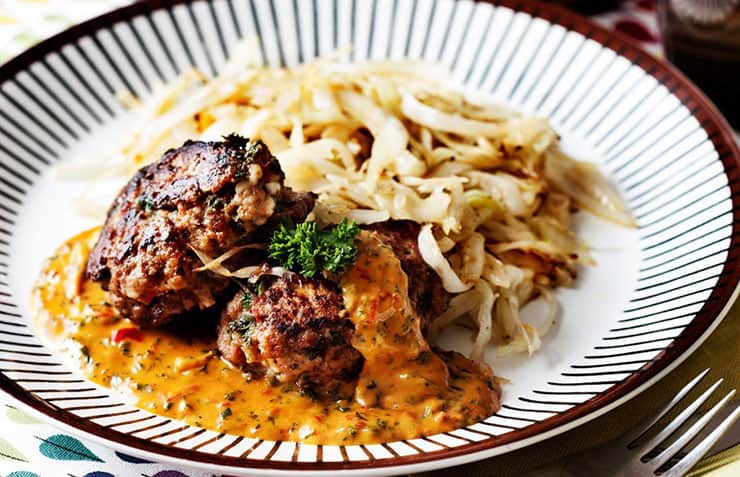 Hamburger Patties with Creamy Tomato Sauce and Fried Cabbage
Hamburger Patties with Creamy Tomato Sauce and Fried Cabbage
Breakfast
Bacon (pastured) and Eggs
Lunch
Eat out:
Grilled chicken without the bun, Asparagus instead of fries and a side of sliced avocado
OR
Hamburger without the bun with a side salad
From home:
Chicken & Kale Caesar-Style Salad
Snack
Handful of macadamia nuts
Dinner
OR
Hamburger Patties with Creamy Tomato Sauce and Fried Cabbage
Or
The Bottom Line
Although the Paleo diet may not be for everyone, it certainly has a great deal to offer. No one will deny that eating more vegetables, drinking less sugar, and dropping refined foods from our diet is good for everyone’s body.
While you might experience some sugar cravings the first few days, most people say that these feelings pass fairly quickly. You might want to consider starting off with the Whole 30 diet plan before starting your Paleo lifestyle. When you consider the numerous health benefits and the plan's common sense approach to nutrition, it’s easy to see why so many people are jumping on the Paleo bandwagon.